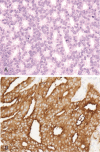Isolated brain metastases as first site of recurrence in prostate cancer: case report and review of the literature
- PMID: 26715888
- PMCID: PMC4687676
- DOI: 10.3747/co.22.2542
Isolated brain metastases as first site of recurrence in prostate cancer: case report and review of the literature
Abstract
Fewer than 2% of patients with metastatic prostate cancer (pca) develop brain metastases. Autopsy series have confirmed the rarity of brain metastases. When present, brain metastases occur in end stage, once the pca is castrate-resistant and spread to other sites is extensive. Here, we present a rare case of a patient with pca who developed a solitary parenchymal brain metastasis as first site of relapse 9 years after radical therapy. The patient underwent craniotomy and excision of the tumour. A second recurrence was also isolated to the brain. In the literature, pca patients with brain metastases have a poor mean survival of 1-7.6 months. The patient in our case report experienced a relatively favourable outcome, surviving 19 months after his initial brain relapse.
Keywords: Prostate cancer; brain metastasis; recurrence.
Figures




References
-
- Howlader N, Noone AM, Krapcho M, et al., editors. SEER Cancer Statistics Review, 1975–2010. Bethesda, MD: US National Cancer Institute; 2013.
-
- Benjamin R. Neurologic complications of prostate cancer. Am Fam Physician. 2002;65:1834–40. - PubMed
LinkOut - more resources
Full Text Sources
Other Literature Sources

